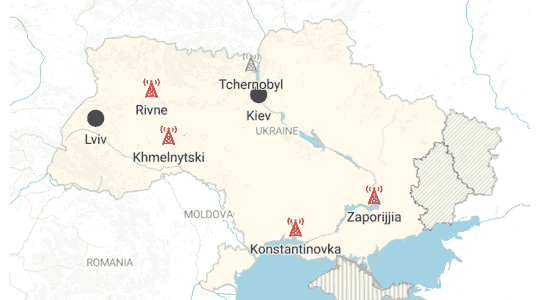An “irresponsible” and “incredibly dangerous” act. A rain of indignant reactions followed the bombardment by Russian tanks, in the night from Thursday to Friday, of the Ukrainian power plant of Zaporozhye, the largest in Europe. Now under the control of the Russian army, this plant is a strategic place for Moscow, since it gives it control over energy – an aspect that has become important in this war. But on the international scene, Vladimir Putin’s actions are worrying. And for good reason: Ukraine is the seventh largest nuclear producer in the world, according to data from the International Atomic Energy Agency (IAEA) for the year 2020. After Chernobyl and Zaporijjia, should we worry about other nuclear power plants in the country?
In total, Ukraine has fifteen reactors currently in working order, all relatively recent. “If there is an explosion, it’s the end of everything. The end of Europe. It’s the evacuation of Europe”, warned, this Friday March 4, the Ukrainian president, Volodymyr Zelensky, It should be noted that these are reactors of Soviet and then Russian design of the VVER type resulting from two different technologies, of respectively 440 and 1000 MW. VVERs are pressurized water reactors, like those installed in France. What reassure us? “A certain number of external aggressions are taken into account in the design of the reactors. (…) On the other hand, these safety devices are not usually dimensioned for war situations”, lights up in L’Express, Karine Herviou , Deputy Director General of the Institute for Radiation Protection and Nuclear Safety (IRSN)
These reactors are distributed in the four nuclear power plants that the country has. From east to west: Zaporizhia, Konstantinovka, Khmelnitsky and Rivne. Let’s start with the most important: the Zaporijjia nuclear power plant, nestled in southern Ukraine, on the Dnieper River. Its major role in the country is reflected in two figures: the site produces a fifth of the country’s electricity and almost half of its nuclear energy. It has a total of six reactors. If it is the first to fall into Russian hands, it is because it is the most easterly in Ukraine, where Russian forces are currently located.
Two plants further west
The development of nuclear power in the country began in the 1970s with the construction of Chernobyl, when Ukraine was part of the Soviet Union. Therefore, the Russians know the Ukrainian nuclear fleet better than anyone. Another nuclear power plant could be in their sights. This is Konstantinovka. On the map of Ukraine, it is located almost 200 kilometers from Kherson, the largest Ukrainian city currently under Russian control. Also called “the nuclear power plant of southern Ukraine”, it has three reactors with a gross power of 1000 MW each – a fourth is under construction. Due to its power, it ranks second among nuclear power plants in Ukraine. The company Energoatom – a state-owned company that has operated all of Ukraine’s nuclear power plants since its creation in 1996 – had raised concerns, telling Reuters on Thursday that fighting had taken place in Voznesensk, about 30 kilometers from the site. .
Further to the northwest, the Rivne power station is currently watching the fighting with a distant eye. Built 400 kilometers from Kiev, it has been relatively spared since the start of the Russian invasion. But the situation could change in the coming days. On Wednesday March 2, the town of Borodyanka, in the north of the country, was attacked by bombardments. Vladimir Putin’s troops seem to want to move to this part of Ukraine, raising fears that the sounds of boots are approaching the Rivne nuclear power plant, made up of four reactors. Finally, there is a fourth plant: located in the west of the country, the Khmelnitsky nuclear site is currently the farthest from the fighting. Like the other three Ukrainian power plants, it was built and commissioned in the 1980s. It is the smallest of the Ukrainian nuclear power plants, with a total capacity of 2000 MWe.
If the last two power stations are on the road to Lviv – located 70 kilometers from the border, it has become a city of refuge for Ukrainians – concern nevertheless occupies people’s minds. This Thursday, Emmanuel Macron’s remarks were hardly optimistic, suggesting that his Russian counterpart wanted to “take control of the whole country”. According to Anna Colin Lebedev, professor-researcher at the University of Paris-Nanterre specializing in protest and collective action in Russia and Ukraine, all scenarios are on the table: “With the risk of intensification of Russian attacks and in particular of indiscriminate bombardments, the risk of an accident with major environmental impact is non-zero. Nuclear accident. Pollution of groundwater. Discharges into the atmosphere. In a few hours, war can come closer to us than we think. ”
In addition, the country also has the reactors at the Chernobyl site, which were shut down after the 1986 disaster, the most serious in the history of civil nuclear power. Reactor No. 4, damaged, was first covered in an emergency by a temporary sarcophagus then by a containment arch completed in 2017. The Ukrainian authorities recently noted an increase in radiation at Chernobyl, but the IAEA has was reassuring, considering that the measured values presented “no danger to the public”. Recently, experts have speculated that a rise in radioactivity caused by military commotion may have turned the earth upside down and kicked up contaminated dust.
